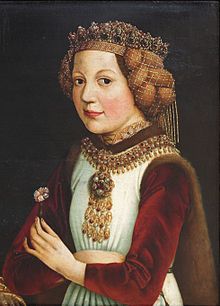Madeleine of France,also calledMagdalena of Valois(1 December 1443 – 21 January 1495), was a French princess who became Princess of Viana by marriage toGaston of Foix.She was the regent of Navarre between 1479 and 1494 during the minority of her two children, each of whom became monarchs of Navarre:Francis IandCatherine I.
| Magdalena of Valois | |
|---|---|
| Princess of Viana | |
 Madeleine of France, as betrothed of Ladislaus the Posthumous, ca 1457 | |
| Born | 1 December 1443 Tours |
| Died | 21 January 1495(aged 51) Pamplona |
| Burial | |
| Spouse | Gaston of Foix, Prince of Viana |
| Issue | Francis Phoebus, King of Navarre Catherine I, Queen of Navarre |
| House | Valois |
| Father | Charles VII, King of France |
| Mother | Marie of Anjou |
Life
editShe was born atTours,a younger daughter ofCharles VII of FranceandMarie of Anjou.[1]
Magdalena was betrothed toLadislaus the Posthumous,but he died suddenly inPragueon 23 November 1457 while preparing for his marriage. It was rumored at the time that his political opponents in Bohemia had poisoned him; but in the 20th century it was proved that Ladislaus died ofleukemia,not a recognized disease in that period.
She instead marriedGaston, Prince of Viana,son and heir ofGaston IV of FoixandEleanor of Navarre,at Saint-Jean-d'Angély in 1461.
Regent of Navarre
editHer husband died in 1470, predeceasing his father; accordingly, when Gaston IV died in 1472, his possessions were inherited by Magdalena's son, Francis Phoebus. Francis became the heir of Navarre in 1479 upon the death of his great-grandfather,John II of Aragon and Navarre,who left Navarre to the rightful heir, Magdalena's mother-in-law, Eleanor. Eleanor only spent a few weeks as queen before she herself died.
Francis Phoebus became king, and his mother acted as regent until his death, at age 15, in 1483. Magdalena continued her regency, then for her daughter, Catherine, until 1494. During this regency, she was forced to battle her brother-in-law, John of Foix, who claimed the throne of Navarre as heir of Francis Phoebus.
In 1483, she arranged for her daughter to be married to a French nobleman on the suggestion of the King of France and refused the match with the heir to the throne of Castile and Aragon, in order to protect Navarre from being united with Castile and Aragon by a French alliance.[2]The marital contract was signed in 1484 and the wedding of her daughter took place in 1486. Her daughter's marriage was not consummated until 1491. It is possible that the consummation, being a political event, was purposely postponed in order to prevent Catherine and her husband from being declared of legal majority, which would allow Magdalena to continue her regency.[3]Magdalena continued to act as regent despite the fact that her daughter had given birth in 1491 and her marriage had clearly been consummated and, at the age of twenty-three, should no longer have the need of a minor regency.[4]Her continued regency even after her daughter's coronation in 1494 is clearly evidenced, as it is documented that she continued to sign charters and was mentioned first officially as regent despite her daughter and son-in-law being adults.[5]
Magdalena was taken hostage byFerdinand II of Aragonin 1494. This ended her regency of Navarre and her daughter and son-in-law are confirmed to have been active rulers from this time onward. She died in the following year atPamplona;her death provoking fresh conflict.
With the death ofCharles VIII of France(Magdalena's nephew), the descendants ofCharles VI of Franceceased to occupy the French throne. By the death ofAnne of France,Magdalena's niece, along with that of her elder sister Yolande, Duchess of Savoy, they became the last surviving legitimate descendants ofCharles VII of France.Her descendant and heir,Henry III of Navarre,would become King of France in 1589, returning the descendants and heirs of Charles VI and Charles VII to the French throne.
Issue
editShe had two children:
- Francis Phoebus(1467–1483), King of Navarre
- Catherine(1470–1517),queen regnantof Navarre, married in 1484John of Albret(1469–1516).
Ancestry
edit| Ancestors of Magdalena of Valois | ||||||||||||||||||||||||||||||||||||||||||||||||||||||||||||||||||||||||||||||||||||||||||||||||||||||||||||||||||||||||||||||||||||||||||||||||||||||||||||||||||||||||||||||||||||||||||||||||||||||||||||||||||||||||||||||||||||||||||||||||||||||||||||||||||||||||||||||||||||||||||||||||||||||||||||||||||||||||||||||||||||||||||||||||||||||||||||||||||||||||||||||||||||||||||||||||||||||||||||||||||||||||||||||||||||||||||||||||||||||||||||||||||||||||||||||||||||||||||||||||||||||||||||||||||||||||||||||||||||||||||||||||||||||||||||||||||||||||||||||||||||||||||||||||||||||||||||||||
|---|---|---|---|---|---|---|---|---|---|---|---|---|---|---|---|---|---|---|---|---|---|---|---|---|---|---|---|---|---|---|---|---|---|---|---|---|---|---|---|---|---|---|---|---|---|---|---|---|---|---|---|---|---|---|---|---|---|---|---|---|---|---|---|---|---|---|---|---|---|---|---|---|---|---|---|---|---|---|---|---|---|---|---|---|---|---|---|---|---|---|---|---|---|---|---|---|---|---|---|---|---|---|---|---|---|---|---|---|---|---|---|---|---|---|---|---|---|---|---|---|---|---|---|---|---|---|---|---|---|---|---|---|---|---|---|---|---|---|---|---|---|---|---|---|---|---|---|---|---|---|---|---|---|---|---|---|---|---|---|---|---|---|---|---|---|---|---|---|---|---|---|---|---|---|---|---|---|---|---|---|---|---|---|---|---|---|---|---|---|---|---|---|---|---|---|---|---|---|---|---|---|---|---|---|---|---|---|---|---|---|---|---|---|---|---|---|---|---|---|---|---|---|---|---|---|---|---|---|---|---|---|---|---|---|---|---|---|---|---|---|---|---|---|---|---|---|---|---|---|---|---|---|---|---|---|---|---|---|---|---|---|---|---|---|---|---|---|---|---|---|---|---|---|---|---|---|---|---|---|---|---|---|---|---|---|---|---|---|---|---|---|---|---|---|---|---|---|---|---|---|---|---|---|---|---|---|---|---|---|---|---|---|---|---|---|---|---|---|---|---|---|---|---|---|---|---|---|---|---|---|---|---|---|---|---|---|---|---|---|---|---|---|---|---|---|---|---|---|---|---|---|---|---|---|---|---|---|---|---|---|---|---|---|---|---|---|---|---|---|---|---|---|---|---|---|---|---|---|---|---|---|---|---|---|---|---|---|---|---|---|---|---|---|---|---|---|---|---|---|---|---|---|---|---|---|---|---|---|---|---|---|---|---|---|---|---|---|---|---|---|---|---|---|---|---|---|---|---|---|---|---|---|---|---|---|---|---|---|---|---|---|---|---|---|---|---|---|---|---|---|---|---|---|---|---|---|---|---|---|---|---|---|---|---|---|---|---|---|---|---|---|---|---|---|---|---|---|---|---|---|---|---|---|---|---|---|---|---|---|---|---|---|---|---|---|---|---|---|---|---|---|---|---|---|---|---|---|---|---|---|---|---|---|---|---|---|---|---|---|---|---|---|---|---|---|---|---|---|---|---|---|---|---|---|---|---|---|---|---|---|---|---|---|---|---|---|---|---|---|---|---|---|---|---|---|---|---|---|---|---|---|---|---|---|---|---|---|---|---|---|---|---|---|---|---|---|---|---|---|---|---|---|---|---|---|---|---|---|---|---|---|---|
| ||||||||||||||||||||||||||||||||||||||||||||||||||||||||||||||||||||||||||||||||||||||||||||||||||||||||||||||||||||||||||||||||||||||||||||||||||||||||||||||||||||||||||||||||||||||||||||||||||||||||||||||||||||||||||||||||||||||||||||||||||||||||||||||||||||||||||||||||||||||||||||||||||||||||||||||||||||||||||||||||||||||||||||||||||||||||||||||||||||||||||||||||||||||||||||||||||||||||||||||||||||||||||||||||||||||||||||||||||||||||||||||||||||||||||||||||||||||||||||||||||||||||||||||||||||||||||||||||||||||||||||||||||||||||||||||||||||||||||||||||||||||||||||||||||||||||||||||||
References
edit- ^Anthony, Raoul: Identification et Étude des Ossements des Rois de Navarre inhumés dans la Cathédrale de Lescar, París, Masson, 1931.
- ^Woodacre, Elena (2013). The Queens Regnant of Navarre: Succession, Politics, and Partnership, 1274-1512. Palgrave Macmillan.
- ^Woodacre, Elena (2013). The Queens Regnant of Navarre: Succession, Politics, and Partnership, 1274-1512. Palgrave Macmillan.
- ^Woodacre, Elena (2013). The Queens Regnant of Navarre: Succession, Politics, and Partnership, 1274-1512. Palgrave Macmillan.
- ^Woodacre, Elena (2013). The Queens Regnant of Navarre: Succession, Politics, and Partnership, 1274-1512. Palgrave Macmillan.